In the early 1800s long flue systems were installed at all the major smelt mills of the North Pennines ore field and locally at the smelt mills of Allendale, Ramshaw (near Blanchland), Allenheads, Rookhope , Nenthead and Castleside. The flues extended long distances up the fells to a vertical terminal chimney. These chimney systems drew the poisonous fumes away from the smelt mill hearths and furnaces and their highly skilled smelters and allowed the lead and silver vaporised in the fumes to condense on the interior walls of the flues. Little remains of the Rookhope Chimney as compared with those of Ramshaw and Allendale where the terminal chimneys and long intact sections of the flues can still be seen, but there is still a solitary arch of the viaduct of six arches which carried the gases over the Rookhope to Allenheads road and the Rookhope Burn to twin flue bores, the entrance to which still exists (just). This arch has become a de facto icon for the village of Rookhope and has given great local awareness of the Rookhope Chimney.
The lead dust was scraped from the flue walls, flushed down the flues with water and then collected near the smelt mill in settling tanks. The lead condensate was then recycled through the mill to be formed into lead ingots. The flues were cleaned off by mill workers, not by boys, as is often stated. Coal mines did employ children, lead mines did not. The dust scaping would have been a horrible task. The flues would still be hot and dark, very dusty, cramped, long, and of course extremely unhealthy.
Lead was valuable whereas labour was cheap and, especially in the case of those who scraped the flues, expendable. So thousands of tons of stone were quarried and fashioned by skilled masons into long flue lines and yet such were the recovery rates from the chimneys and their profitability that it is reckoned that their capital cost was recouped within a few years of operation. The flues at Rookhope and Allenheads extended to the top of the fell and would almost certainly have been longer if that had been possible. The residual fumes from the terminal chimney at Rookhope were still such that a large area of the surrounding peat has been contaminated and destroyed, leaving large sterile “ponds” of mud and sand even today. There was a more limited head room above the smelt mill at Ramshaw for long flues so Ian Forbes who surveyed them says their flues were extended by a series of loops.
It is not known whether the Rookhope flues were demolished or collapsed. All that remains of the smelt mill and chimney system are the arch, vestiges of the wooden settling tank above the car park near the arch, the entrance to the flues, the 1.5 mile trace of the flues up the fell side, and the ruins of an entrance into the flues and of the terminal chimney. Lenny Willis of Rookhope remembers playing in the area of the chimneys as a boy and says there were a number of dammed ponds along the flues, fed from the hillside, which were used in the flushing operations. These are now overgrown and difficult to pick out. Higher up the flues there are sections where the stone used is still in situ but at the bottom it has been largely removed and reused. To the right of the flues and below the terminal chimney there are the disused quarries from which the stone used to construct the flues was extracted.
Local historian, Alan Blackburn, says that from the 1890s the lead dust found a more profitable use in the manufacture of lead paint. “The fine dust from the smelting process will give either a grey oxidised lead, or if very hot, a red one that will make red lead paint when mixed with linseed oil. The settling tanks took the washings and then the water was slowly drained off and the sludge sold. I was told it was like a jelly and could be cut with a spade. When mixed, the oil will remove any remaining water.”
Alan says the terminal chimney at Rookhope is unusual in that it was made of wood above a stone base and this is confimed by Lenny Willis who met Tommy Maddison, a joiner, in the 1970s who had worked on the maintenance of the woodwork of the chimney. Alan has reconstructed what the Rookhope terminal chimney looked like from a description given to him by “that grand old man of Rookhope, John Foster” and his sketch is reproduced in the photo gallery below.
If you want to inspect the insides of a flue and a terminal chimney then download details of an easy 2.5 mile walk near Allendale provided by the North Pennines AONB HERE.
If you wish to climb up the path of the flues of the Rookhope Chimney park opposite the Rookhope Arch in a semi circular car park. Walk towards Rookhope for 75 yards and then turn left onto Open Access land, through a gate and up a green and overgrown track. After 100 yards turn left at a track junction and follow this track for 1.5 miles up the fell to the ruins of the terminal chimney. Come back the same way. The ascent is approximately 700 feet.
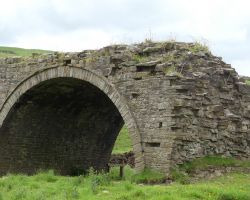

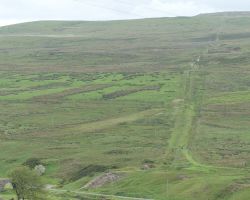

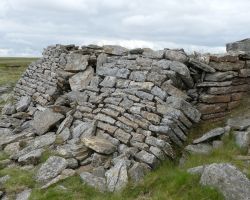
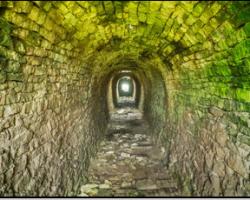
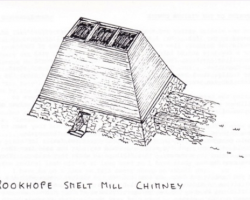
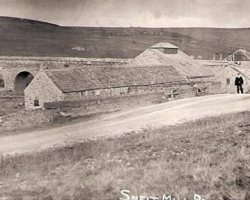
Fascinating. Thank you.